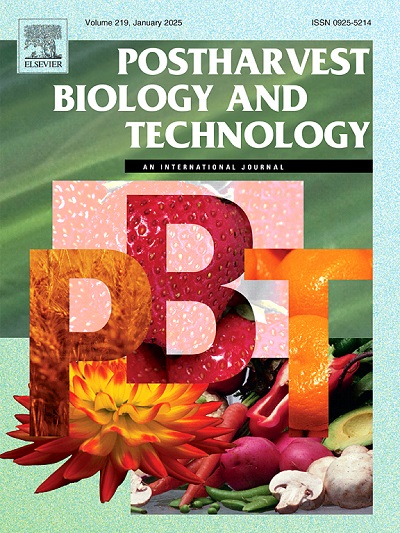Electron beam irradiation maintains postharvest quality of Actinidia arguta by regulating the cell wall, starch degradation, and antioxidant capacity
IF 6.4
1区 农林科学
Q1 AGRONOMY
引用次数: 0
Abstract
Rapid postharvest softening, a major issue with Actinidia arguta, leads to a decline in quality and in commercial value. To maximally preserve fruit quality, the effects of different doses of electron beam irradiation (0.4 kGy and 1 kGy) on fruit softening and the antioxidant capacity of A. arguta after 30 days of storage were investigated. The results indicated that, compared to unirradiated fruits, A. arguta fruit subjected to electron beam irradiation maintained high levels of firmness, total phenols, flavonoids, protopectin, starch, and sucrose, and exhibited low levels of malondialdehyde and reducing sugars. Fruit receiving 1 kGy irradiation exhibited the highest firmness; however, a significant reduction in firmness was observed immediately after irradiation (day 0). An irradiation dose of 0.4 kGy did not decrease fruit firmness, and there were no significant differences in the contents of protopectin, starch, sucrose, total phenols, and flavonoids compared to fruits treated with 1 kGy irradiation. A transcriptomic analysis revealed that electron beam irradiation significantly downregulated the most genes associated with the cell wall and starch degradation, and significantly upregulated some genes related to antioxidant activity. Furthermore, there was a positive correlation between the upregulated and downregulated gene expression levels and the radiation dose. The unigenes obtained from the transcriptomic analysis were validated through integrated RT-qPCR, proteomic, and transcriptomic correlation analyses. Overall, these findings indicated that electron beam irradiation is an effective method for delaying the softening of A. arguta.
求助全文
约1分钟内获得全文
求助全文
来源期刊

Postharvest Biology and Technology
农林科学-农艺学
CiteScore
12.00
自引率
11.40%
发文量
309
审稿时长
38 days
期刊介绍:
The journal is devoted exclusively to the publication of original papers, review articles and frontiers articles on biological and technological postharvest research. This includes the areas of postharvest storage, treatments and underpinning mechanisms, quality evaluation, packaging, handling and distribution of fresh horticultural crops including fruit, vegetables, flowers and nuts, but excluding grains, seeds and forages.
Papers reporting novel insights from fundamental and interdisciplinary research will be particularly encouraged. These disciplines include systems biology, bioinformatics, entomology, plant physiology, plant pathology, (bio)chemistry, engineering, modelling, and technologies for nondestructive testing.
Manuscripts on fresh food crops that will be further processed after postharvest storage, or on food processes beyond refrigeration, packaging and minimal processing will not be considered.
 求助内容:
求助内容: 应助结果提醒方式:
应助结果提醒方式:


